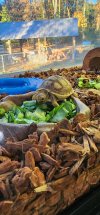WarrenPeace
New Member
My new sulcata tortoise is about 8 weeks old. I'm terrified lol.
How much humidity and how do I control it.
I read to soak them then I read not to...
I read don't change what they eat alot (they were feeding spring greens) then I read feed them what is good for them.
Also spring greens has spinach and I read they shouldn't have it?
The internet is failing me lol. Can anyone give me some basics so I can get this guy comfortable while I'm catching up? Thank you so much!
How much humidity and how do I control it.
I read to soak them then I read not to...
I read don't change what they eat alot (they were feeding spring greens) then I read feed them what is good for them.
Also spring greens has spinach and I read they shouldn't have it?
The internet is failing me lol. Can anyone give me some basics so I can get this guy comfortable while I'm catching up? Thank you so much!


